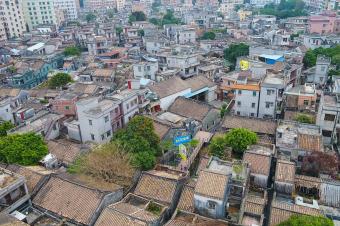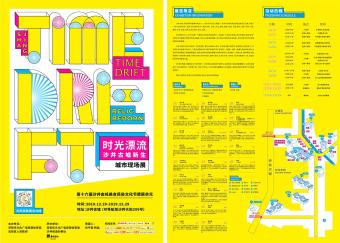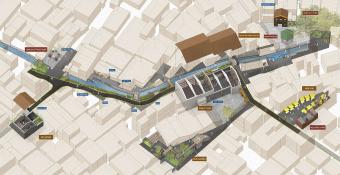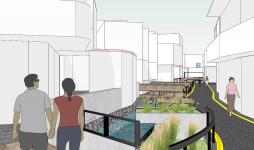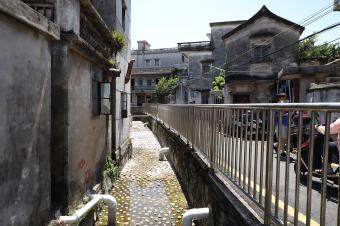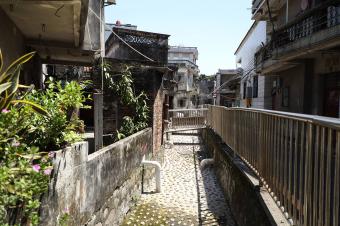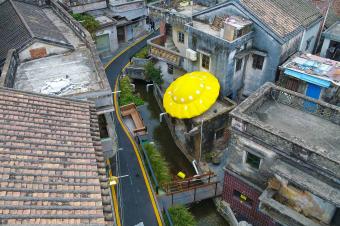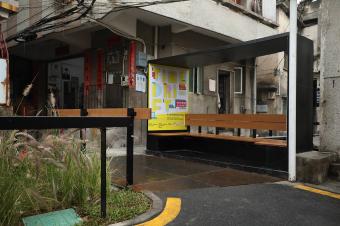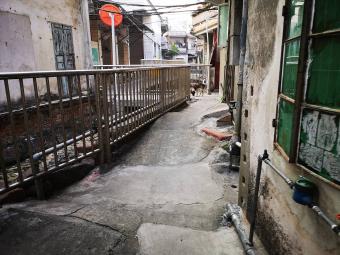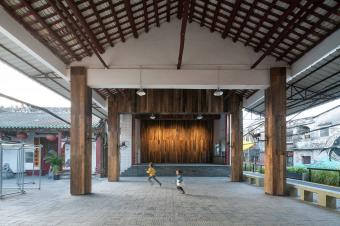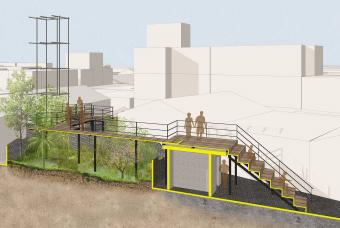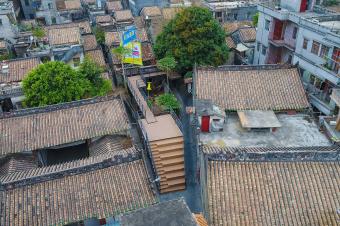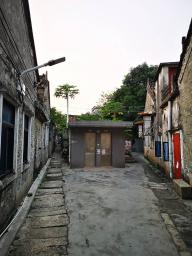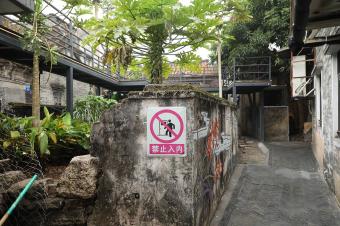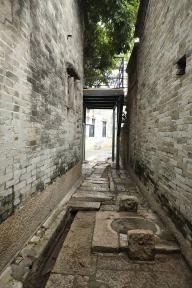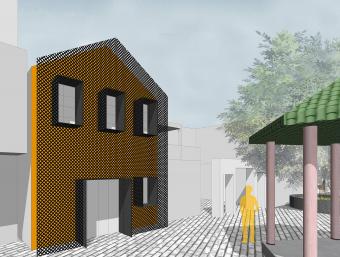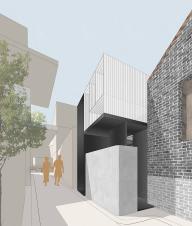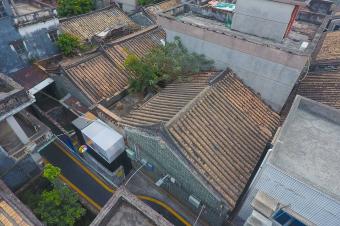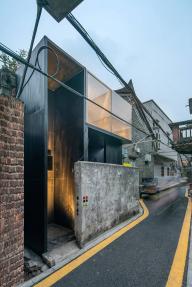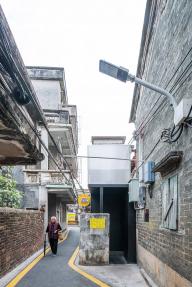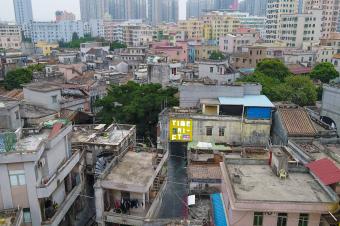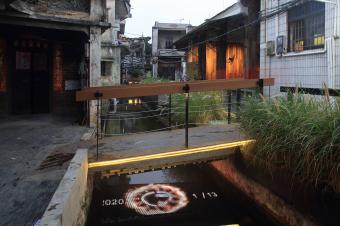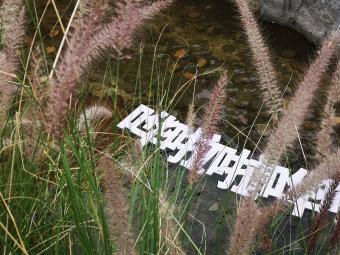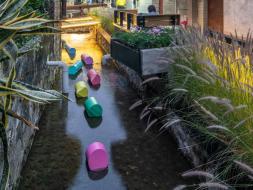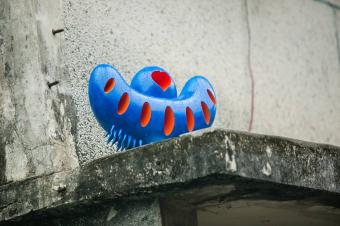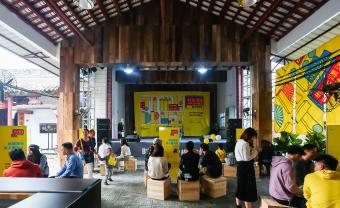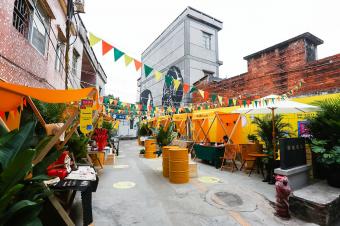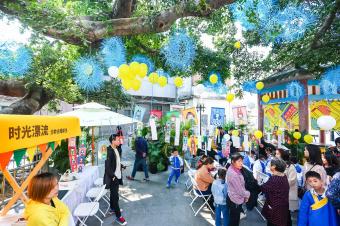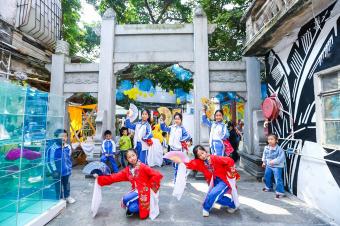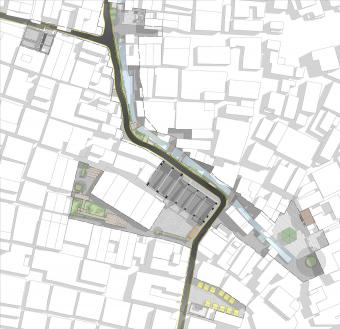深圳沙井古墟新生景观设计 | 趣城工作室
-
项目名称:沙井古墟新生
-
项目地点:深圳
-
项目规模:3000.0平方米
-
设计公司:
-
委托方:深圳市宝安区沙井街道办、华润置地集团
-
建成时间:2019
-
图片来源:白羽、朱锐、快乐享印
沙井古墟地处深圳市宝安区沙井街道,是深圳现存最大的混合型历史街区,占地面积约26万平方米。包括一条古老的河流——龙津河,一幢上千年历史的南宋建筑遗址——龙津石塔,以及几百栋老屋、十几处祠堂,若干古井、牌坊、废墟和遗迹等。今天,它又混杂了城中村、临时建筑与非正规移民社区,整体风貌呈现出极具特色的新旧杂陈和多元共生状态。
Located on Shajing Street in Baoan District, Shenzhen, Shajing Ancient Fair is the largest existing historical district in Shenzhen, , about 260,000 square meters. It includes an ancient river – Longjin River, a thousand-year-old Southern Song architectural site – Longjin Stone Pagoda, as well as hundreds of old houses ancestral halls, ancient wells, and other historical sites., etc. At present, Shajing consists of urban villages, temporary buildings and informal immigrant communities.
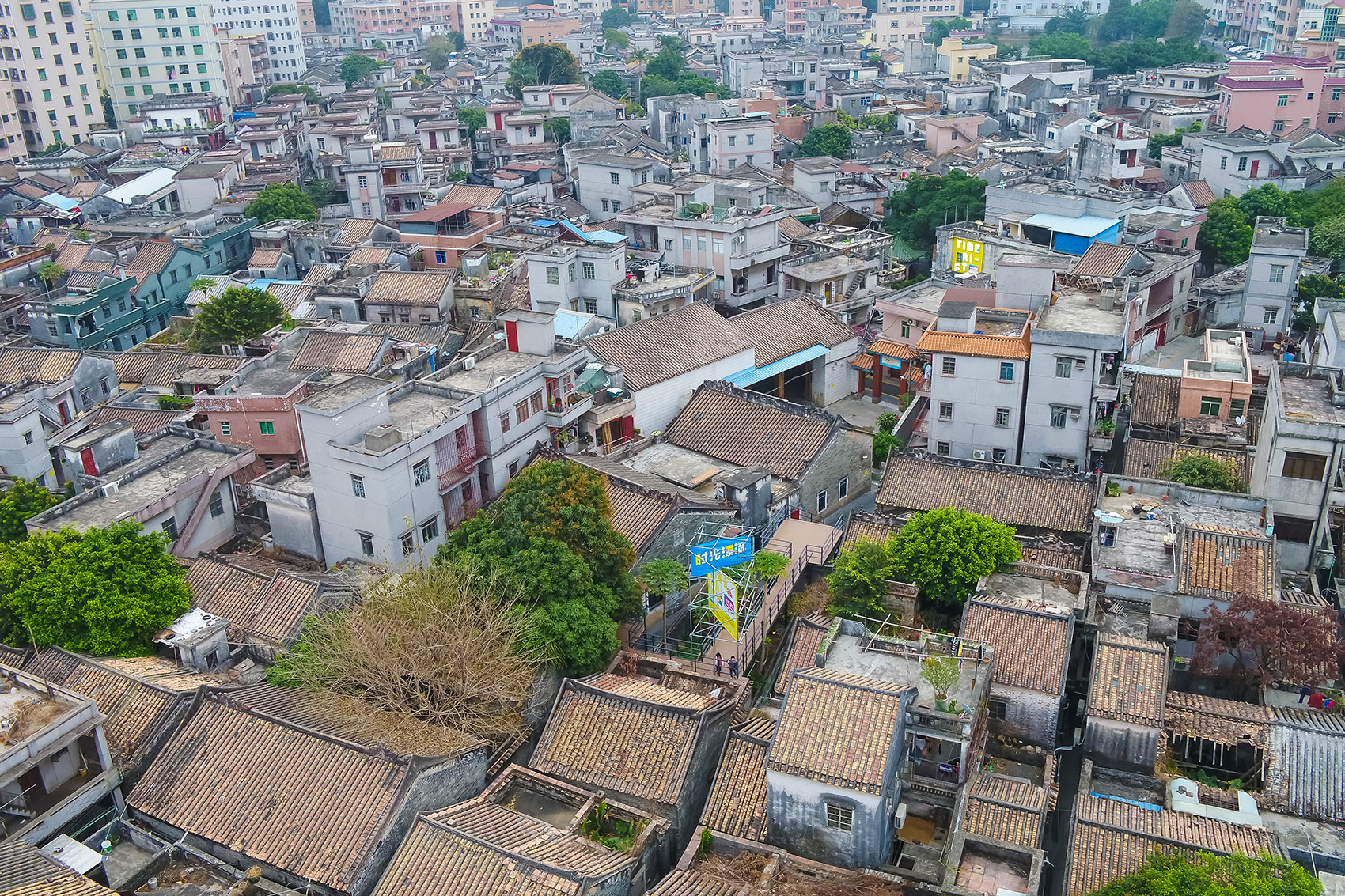
▲沙井古墟是深圳现存最大的混合型历史街区,Shajing Ancient Fair is the largest surviving mixed historic district in Shenzhen. ©雪里红文化 XUELIHONG

▲沙井古墟航拍,Aerial photography of Shajing Ancient Fair ©雪里红文化 XUELIHONG
为了最大限度地保护沙井古墟的历史文化价值,探索一种基于新的设计理念和设计方法之上的城市更新与城市价值再生模型,趣城工作室(ARCity Office)受沙井街道办和华润置地集团委托,策划、设计了一组景观/建筑/室内设计微改造(含新建)项目,同时作为策展人,一并策展了“时光漂流-沙井古墟新生城市现场展”,在真实的街道&村落生活场景之中植入现场展览,同时组织村民和社区开展各种类型的公共活动,期望借助有创意的设计和展览,发现历史遗存的独特美学价值,创造全新的文化融合场景,激活已经趋于衰败的地方生活社区。沙井古墟新生计划和时光漂流城市现场展,从2019年9月初开始,到2019年12月底全部完成,整个策划、设计、策展和展览过程历时四个月。
In order to preserve the historical and cultural values of Shajing Fair, and to explore a model of urban renewal and urban value regeneration, ARCity Office was commissioned by Shajing Street Office and China Resources Land Limited to design a set of landscape/buildings/interior reconstruction projects. At the same time, ARCity Office curated “Time Drift -Shajing Relic Reborn urban site-specfic exhibition” and organized various public activities for villagers to help them discover the unique aesthetic value of historical remains. Through these creative designs and exhibitions,architects aim to create new cultural integration scenes, and activate local communities which are in a state of decay. The entire processes of planning, design, curation and exhibition began in early September 2019 and was fully completed by the end of December 2019.

▲时光漂流-沙井古墟新生城市展览主海报(策展人:张宇星、韩晶,展览视觉设计:SURE Design),Exhibition poster – Rejuvenation of Shajing Ancient Fair urban site-specific exhibition (curated by Zhang Yuxing and Han Jing,VI design by SURE Design)
沙井古墟新生
Rejuvenation of Shajing Ancient Fair
沙井古墟新生是一个包含了河流整治、景观设计、建筑和室内设计等项目在内的历史空间保护、激活、再生系列计划,其主体项目是对龙津河的一段(约70米)进行示范性的水体整治和景观改造。同时,在龙津河沿岸选择了有代表性的场域地点(如废墟、老屋、戏台等),采用“融合设计”方法,在保持场所特质的基础上,删繁就简、顺势营造,增加整个地区的在地空间吸引力。
Rejuvenation of Shajing Ancient Fair is an urban micro-regeneration project which include river management, landscape design, architecture and interior design. The main task is to redesign the landscape of a section of the Longjin River which is about 70 meters. At the same time, important sites (such as ruins, old houses, theatres, etc.) were selected and redesigned by an approach of “fusion design”. In this way, architects increase the heterogeneity of the site and maintain spatial textures to activate the entire area.

▲沙井古墟新生-设计范围,Rejuvenation of Shajing Ancient Fair -Design Scope ©趣城工作室
沙井古墟新生,类似于一种“针灸疗法”,选择最关键的经脉、穴位,对其进行轻微干预,避免因为突兀的设计介入而造成地区社会结构和空间纹理的断裂。包含六个(组)改造和新建设计项目,分布于龙津河两侧:A、龙津河河岸景观;B、龙津水榭;C、戏台;D、废墟花园;E、山墙之家;F、老屋影像馆。
Rejuvenation of Shajing Ancient Fair adopt a method of ” acupuncture therapy “, selecting the most critical sites and intervening slightly to avoid the fracture of the social structure and spatial texture. This project consists of six groups of renovation and new designs located on both sides of the Longjin River: A.Landscape of Longjin River Bank ; B. Longjin Water Pavilion; C. Public Stage; D. Ruin Garden; E. House of Gable Wall; F. Old House Image Gallery.
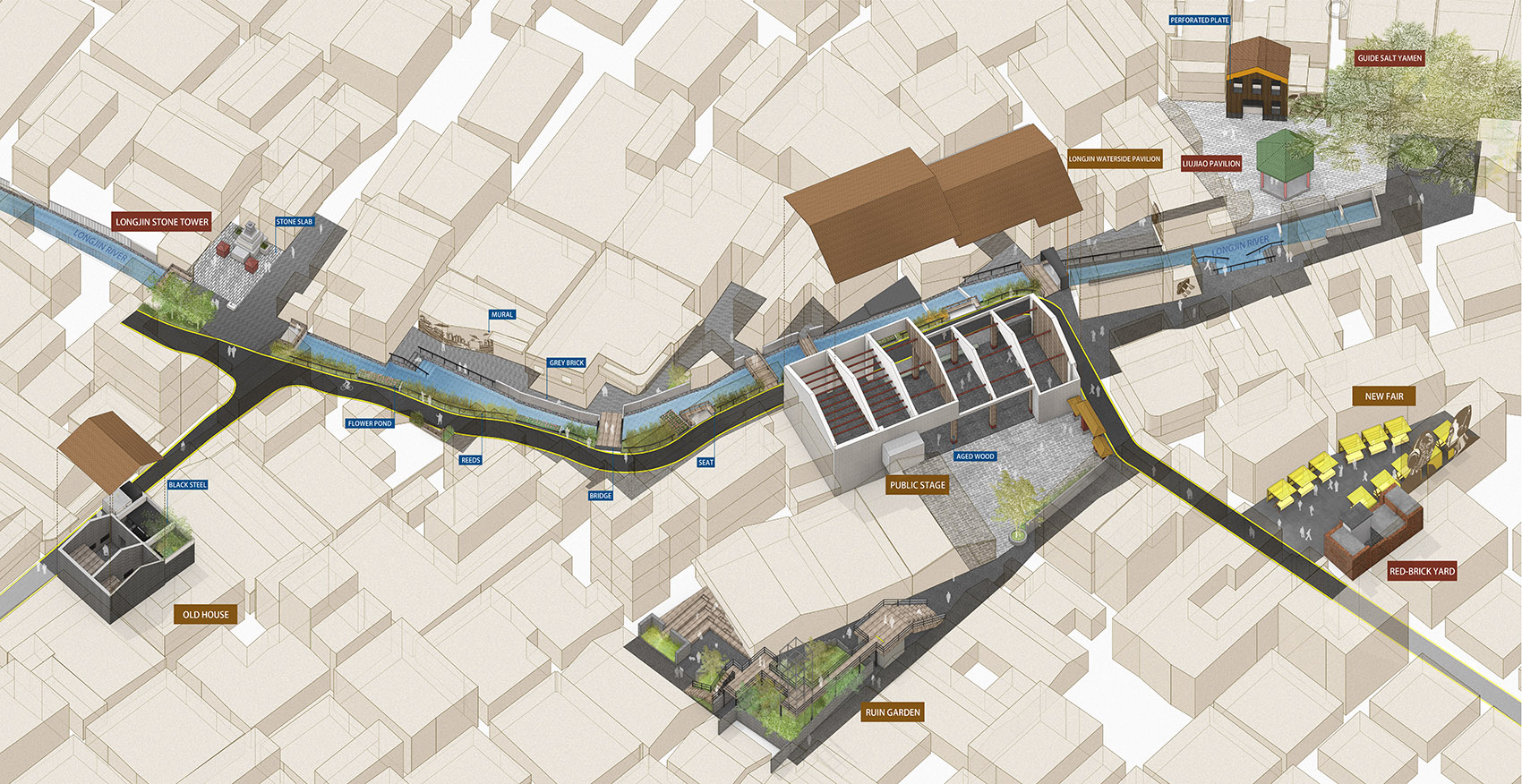
▲六个(组)改造和新建设计项目分布于龙津河两侧,Six (group) renovation and new design projects on both sides of the Longjin River ©趣城工作室
龙津河河岸景观——用低成本方法让被污染的古老河流重获新生
Landscape of the Longjin Riverbank – a low-cost way to revive a polluted ancient river
龙津河曾经通航,从沙井古墟穿过直接流向珠江,是古代市集、贸易、运输的重要通道。后来由于墟市的衰弱,河道被逐渐填塞、减窄、污染,变成一条宽度仅为2米左右的黑臭水体,并且被用铁栏杆围护起来,防止人掉入其中。项目采用低成本的雨污分流方法,把现有河道的纵 剖面分为上下两层:下层是污水箱涵;上层是雨水通道(在没有雨水时,可以将附近污水处理厂处理过的中水注入其中)。
Longjin River was once essential for trade and transportation. Later on, due to the decline of Shajing, the river channel was gradually filled in, narrowed and polluted , turning into a 2-meter wide odorous gutter. Architects adopt a low-cost rain and sewage diversion strategy to divide the channel into two layers. The lower layer is sewage, and the upper is rainwater. Thus, when there is no rainwater, the upper one can be filled by reclaiming filtered water from nearby sewage plant.
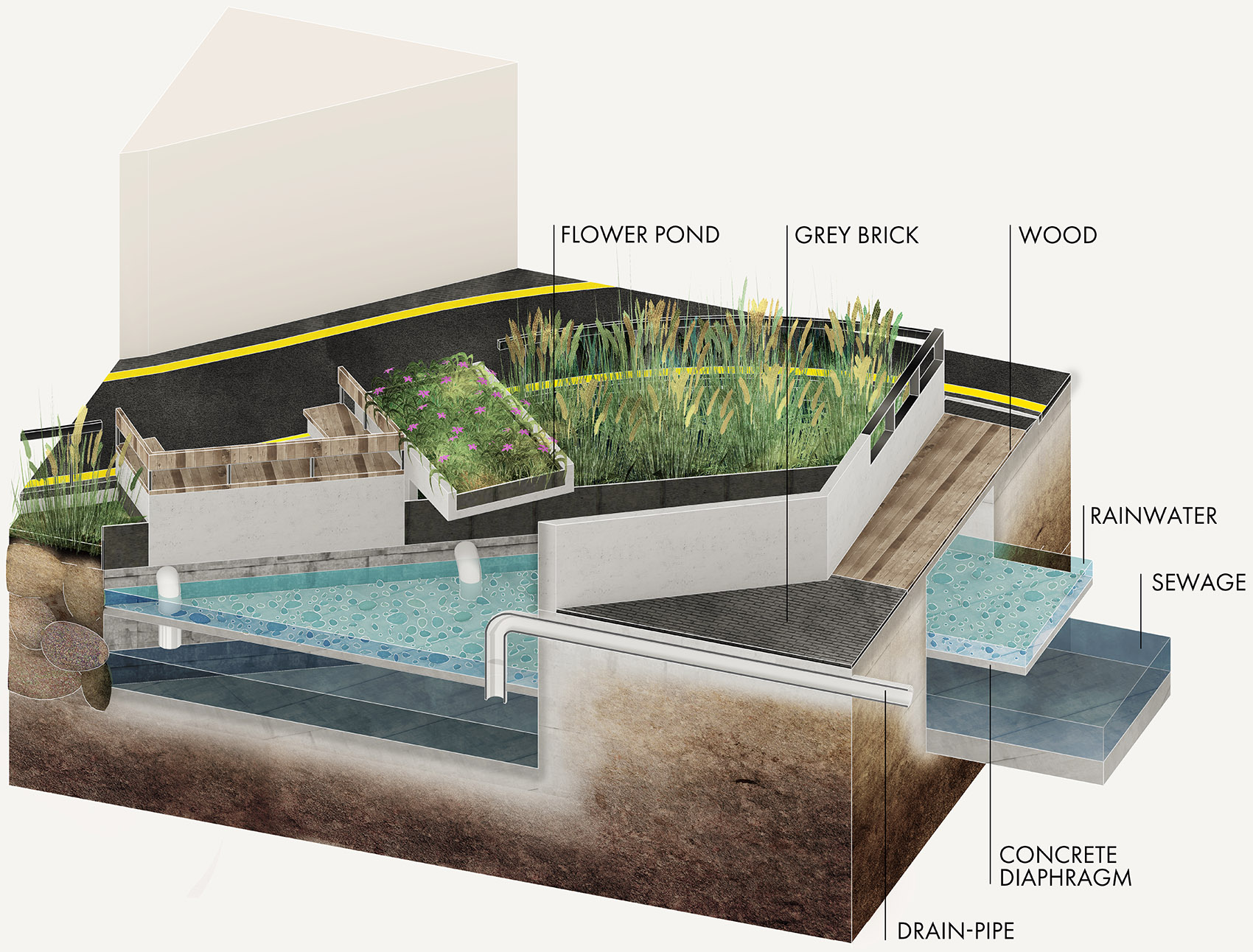
▲龙津河雨污分流改造-河道剖面示意,Longjin River rainwater and sewage diversion renovation – section of the river ©趣城工作室
进一步,将河岸两侧的栏杆取消,把封闭的河流完全打开,交还给市民,并在河岸两侧设计了一组花池、座椅、小桥、步道等,使龙津河焕发出生机。于是河流得以重新回归日常生活,成为人们可以亲近、触摸、玩耍和游戏的场景。
Further, a set of flower ponds, seats, bridges, and walking paths were designed to revitalize the Longjin River by removing the railings on both sides of the river bank. The space of river bank was returned the public. As a result, this site was able to contain daily life and become a scene that people could get close to enjoy and experience.

▲龙津河河岸景观改造设计意向图,river bank landscape reconstruction of Longjin River ©趣城工作室

▲雨污分流改变了河道剖面,利用现有河道解决污水排放问题,Stormwater diversion changes river section, using existing watercourses to solve sewage discharge problems ©张宇星 ZHANG Yuxing
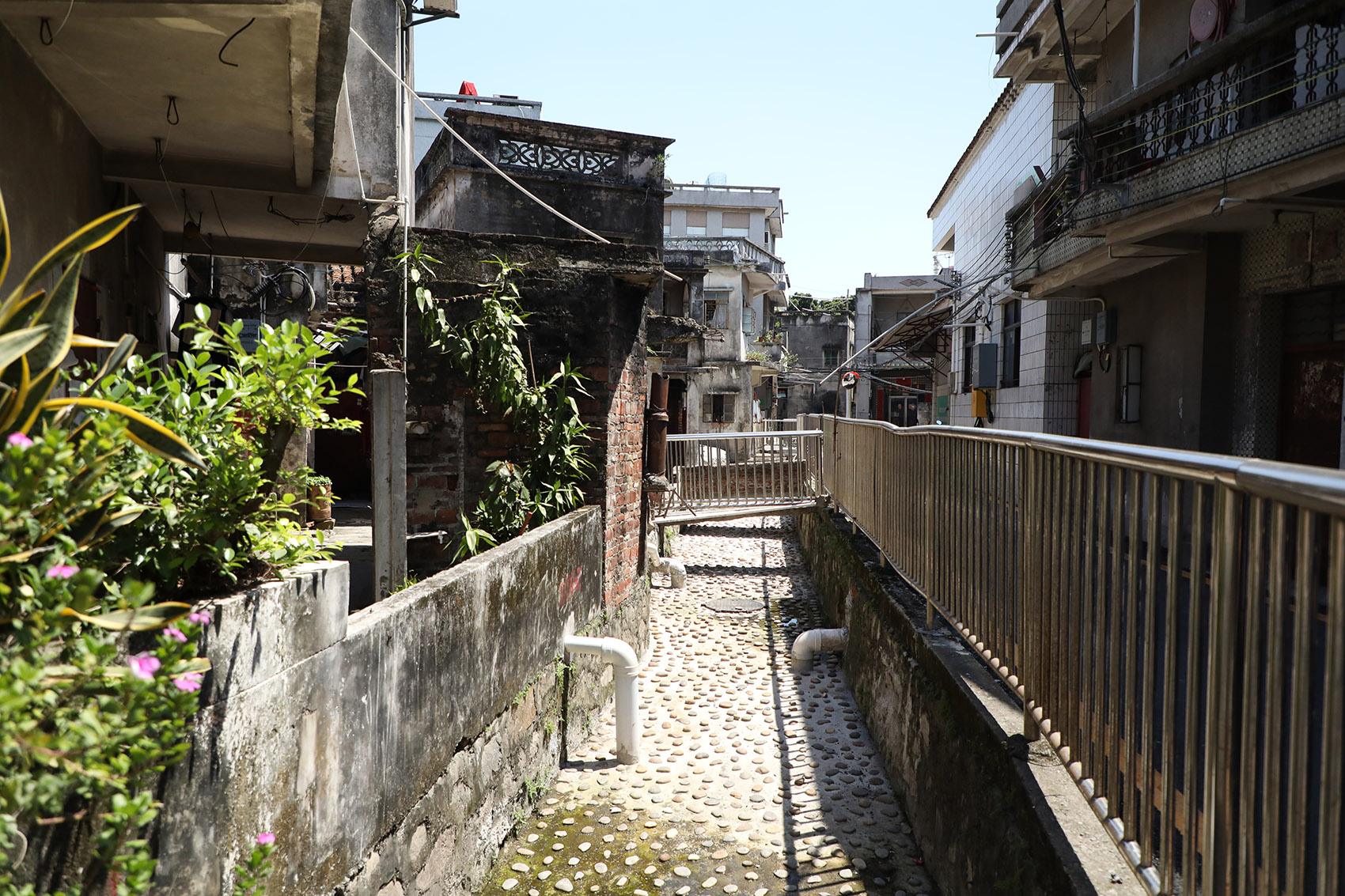
▲雨污分流维持了村落现有排水系统,Sewage diversion maintains the existing drainage system in the village ©张宇星 ZHANG Yuxing

▲河流重新成为有趣的日常生活场景,Riverbank as interesting everyday scenes ©朱锐 ZHU Ruix

▲河道两侧有很多潜在的场所空间,Potential places on both sides of the river ©张宇星 ZHANG Yuxing
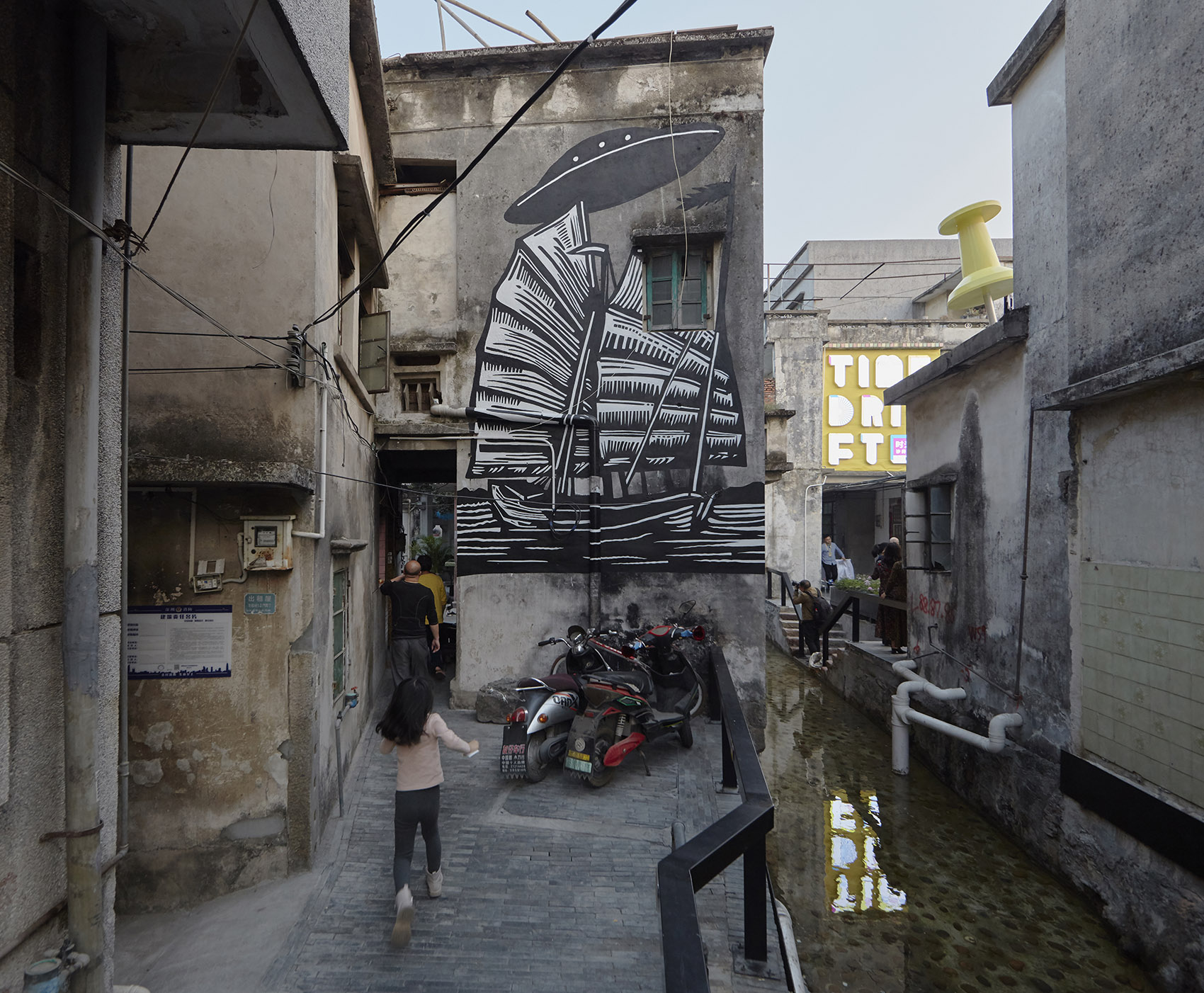
▲通过设计和展览将河流转化为有意义的场所,Make riverbank interesting places through design and exhibitions ©朱锐 ZHU Rui
龙津河一侧的道路完全挤压到河流边,“道路争抢河流”的现象非常严重。即使如此,道路仍然处于无序杂乱之中,汽车、摩托车、电瓶车、行人等混行在一起,交通效率并不高。对此,设计提出了一种平衡性解决方法:对道路线型重新设计,采用“道路裁剪”方法,把道路线型适当弯曲,将一些不必要的道路线宽减窄,还给河流水体和河岸景观,道路瓶颈处则适当加宽。
The roads on the side of Longjin river are completely squeezed to the river’s edge, and the phenomenon of “road competition for the river” is rampant. Even so, the road is still in a haphazard state, with cars, motorcycles, battery-powered vehicles, and pedestrians mingling with each other, making traffic efficiency low. In this regard, the design proposed a balanced solution: the redesign of the road line, the use of “road cutting” method, the road line appropriate curves, some unnecessary road width to reduce the narrowing of the river, to return to the water bodies and riverbank landscape, road bottlenecks are properly widened.

▲重新设计后的道路,road after renovation ©雪里红文化 XUELIHONG
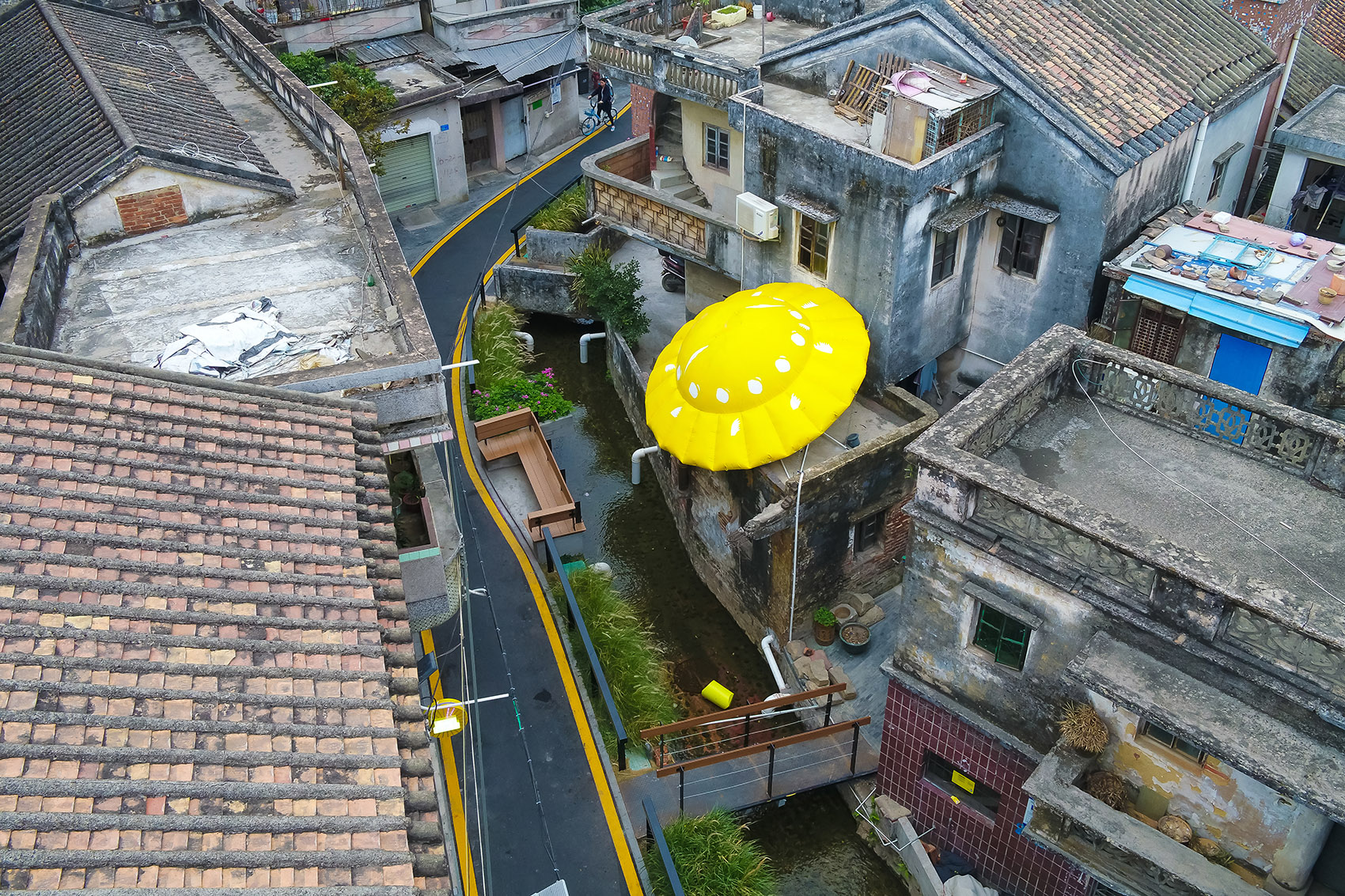
▲路线适当弯曲,不必要的路线减窄,road lines appropriates curves, reducing width at unnecessary part ©雪里红文化 XUELIHONG
道路剪裁之后,“裁直剪曲”无形中增加了很多边角余料空间,可以用于景观绿化、观赏休憩。设计了一些悬挑花池、美人靠座椅、过河小桥,丰富沿岸景观。进一步,将岸边新增边角余料空间的标高降低之地面以下,从视觉上拓宽了河道宽度。
The boundaries of the road were redesigned to provide additional space for landscaping and ornamental recreation. Cantilevered flower pools, beauty seats and bridges over the river were designed to enrich the riverbank landscape. Further, the elevation of the additional space was lowered below the ground level to visually widen the width of the river.
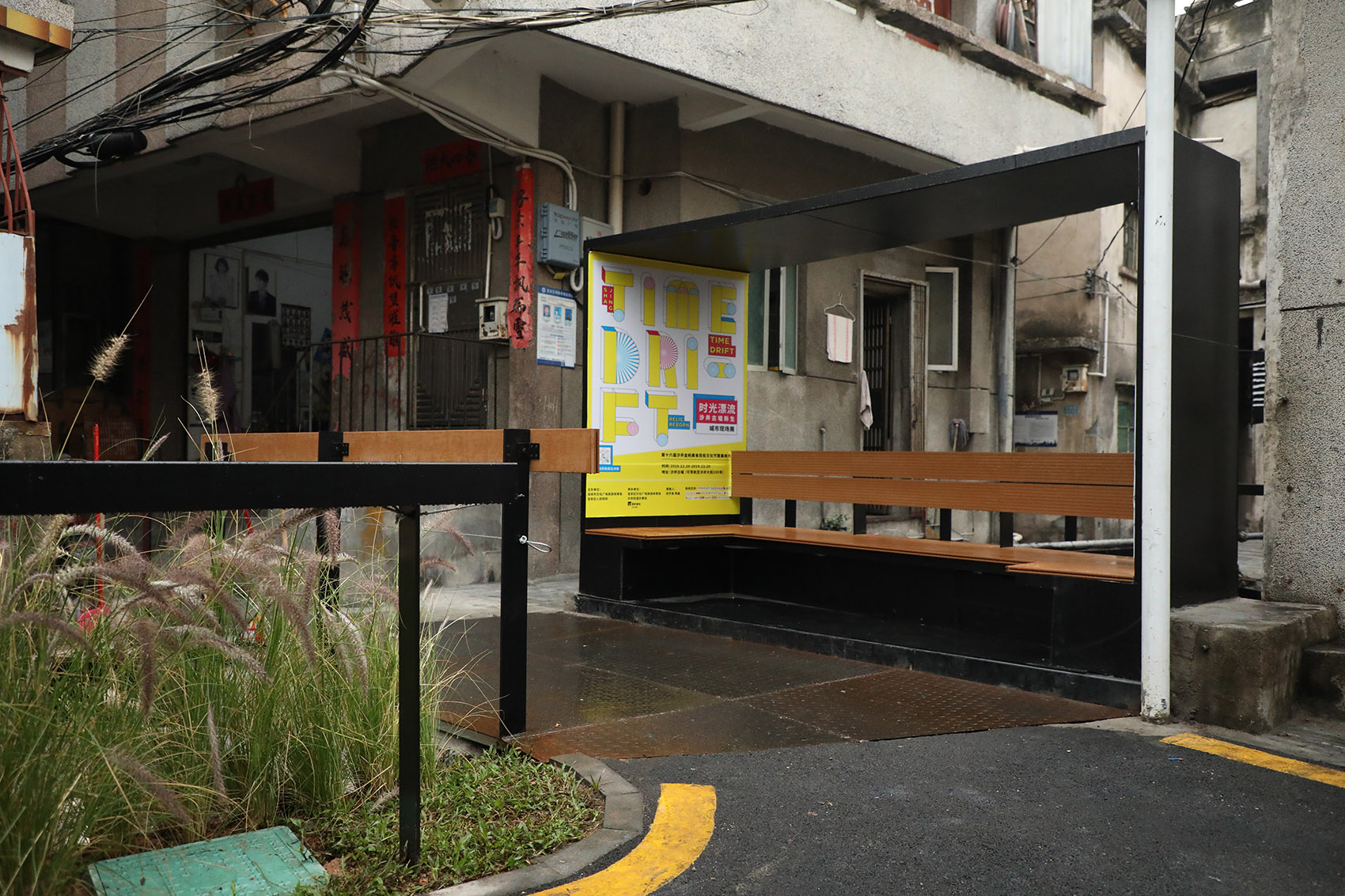
▲从道路中“挤出来”的路边座椅,”Squeezed” out of the road for roadside seating ©张宇星 ZHANG Yuxing
历史上,龙津河的宽度曾经达到5-10米,后来逐渐被填塞,道路和房屋占用了河道。为此,选择局部地点尝试适当增加水体宽度,“还路于河”,设计了亲水台阶,可以供人们在水边玩耍,体验河流的原始魅力。
In the past, the Longjin River used to be 5-10 meters wide. But then the river became blocked, and roads and houses occupied the river. For this reason, architects chose several sites to increase the width of the water body appropriately; and designed water-friendly steps where people can play at the river’s edge to experience the river’s original charm.

▲亲水台阶,water-friendly steps ©白羽 BAI Yu
龙津水榭——设计一个看得见风景的地点
Longjin Viewing Pavilion – Designing a location with a visible view
如果把沙井古墟当成一个大型、开放的“历史场景美术馆”,为了实现步移景异的游览效果,就需要设计独特的游览路径和观看地点,让人们“不经意”地发现历史遗产之美。于是,设计一个看得见风景的地点,也许比设计观看景观本身更加重要。龙津水榭就是这样一个地点,它位于龙津河的一个桥边,横跨在河面上,可以在此观看河流的上下两个方向,也成为村民随意休息交往的微小场所。
If Shajing Ancient Fair could be seen as a large, open “museum of historical scenes”, in order to achieve a promenade architecturale, it is necessary to design unique paths and viewing places that allow people to discover the beauty of the historical heritage unobtrusively. Architects believe that designing a location with a visible view is perhaps more important than designing the landscape itself. One such site is the Longjin Pavilion, which is located by a bridge over the Longjin River. People can watch scenery of the river of both sides here, and the place has become a tiny place for villagers to rest and socialize casually.
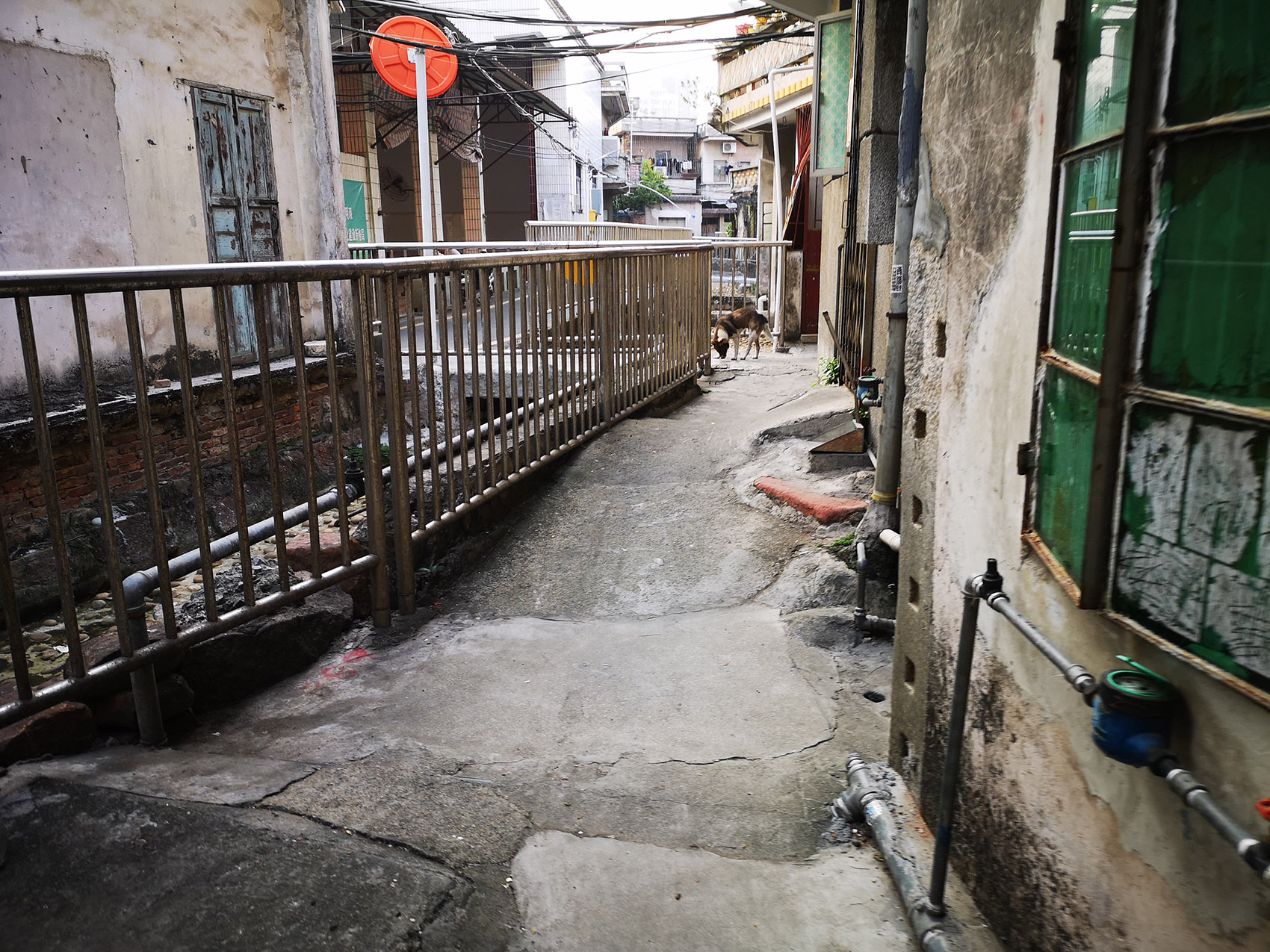
▲水榭边的原始场地坑洼不平,The rugged ground near the pavilion before reconstruction ©张宇星 ZHANG Yuxing
戏台——用公共空间激活地方文化遗产
Public Stage – activating local cultural heritage with public space
沙井古墟的历史文化遗产非常丰富,曾经是南宋归德盐场衙署所在地、200年前的深圳四大墟市之一,也是珠三角著名的蚝乡、粤剧之乡和螳螂拳武术之乡。但是由于整个地区的衰弱,这些传统文化也已经走向式微。建筑师希望通过一系列公共空间的恢复、改造和创造,激发当地文化遗产的复兴。其中,一个重要节点是戏台。戏台建筑原为上世纪八十年代所建,由于年久失修,逐渐成为一个“无用空间”(里面设置了微型消防站)。为了重新恢复戏台功能,设计师用很轻的方法对老建筑进行改造,从当地收集一些旧木材和青砖,用于室内装饰和地面铺装。于是一个具有历史质感的“融合场景”被创造出来,村民组织以及社区机构可以重新利用戏台从事文化活动。
Shajing Ancient Fair has rich historical and cultural heritage. Shajing was one of the four major bazaars in Shenzhen 200 years ago, the Oyster Town of the Pearl River Delta, and the original place of Cantonese opera and mantis fist martial arts. But due to the decline of the entire region, these traditional cultures have also declined. The architects hope to revive the local cultural heritage through the restoration, transformation and creation of a series of public spaces. One of the important places is the public stage. Built in the 1980s, this building has gradually become a useless fire station. Architects redesigned this building by collecting some old wood and bricks from the local area for interior decoration and flooring.Thus, a complex sense of history has been created and villagers can organize activities here.

▲用轻轻触碰、可循环再生的方式营造场所气质,Create a sense of place with a lightly recyclable method. ©趣城工作室


▲利用废旧木材和青砖创造具有历史质感的融合场景,Creating a fusion of historic scenes with salvaged wood and bricks ©白羽 BAI Yu
废墟花园——顺势而为的空中廊桥系统
Ruin Garden- A Skyway Bridge System
在戏台附近有一处建筑废墟,长期荒废变成了杂草丛生的空地,有居民在此种菜。建筑师利用废墟边的公共厕所屋顶,顺势设计了一个空中廊桥系统,包括大台阶、空中栈道、脚手架海报塔等,让人们可以走到二层标高,近距离观赏近在眼前的历史建筑群(包括两个祠堂、一个家塾、环绕周边的老建筑群)。同时,利用废墟一侧的小空地,将其改造成为室外广场,铺上木板,可以坐在此处休息,也可以从事小型交往、休闲、聚会、体育活动(比如在此练习螳螂拳)。
There is a building ruin near the pulbic stage, and after a period of time some residents grow vegetables here. Architects used the roof of the public toilet beside the ruins to construct a sky bridge system, including a large staircase, a skywalk, a Scaffolding poster towers, etc., People are allowed to walk up to the second-story elevation and get a closer look at the historic buildings, including two shrines and a home school. At the same time, the small open space on the side of the ruins was utilized and transformed into an outdoor plaza with wooden planks where villagers can sit and relax or engage in small social and sporting activities,such as practicing mantis boxing

▲废墟花园设计意向图,Ruin Garden ©趣城工作室


▲废墟花园航拍,Aerial photography of Ruin Garden ©雪里红文化 XUELIHONG

▲通往废墟花园处有一个公共厕所,A public toilet on the way to the ruined garden. ©张宇星 ZHANG Yuxing

▲利用公共厕所屋顶顺势设计了大台阶和廊桥系统,A system of steps and sky bridges using the public toilet roof ©白羽 BAI Yu

▲在完整保护废墟遗址的基础上增加空中步道,Addition of sky trails based on protection of ruined sites ©张宇星 ZHANG Yuxing

▲新增的空中廊桥系统与废墟完全脱开,The new sky bridge system is completely detached from the ruins ©张宇星 ZHANG Yuxing
山墙之家——发现并塑造日常生活的戏剧性
House of Gable Wall – Discover and create the theatricality of everyday life
龙津河水闸处的六角亭广场,是整个沙井古墟新生计划的核心区域之一,汇集了众多历史古迹,包括六角亭、古牌坊、归德盐场衙署遗址、围头古井、观音庙等等,这儿也是当地村民休闲、聚集的场所。建筑师选择了六角亭正对面的一栋老屋(一楼是麻将馆,二楼为居住)山墙立面进行改造,试图在已经非常丰富的历史场景中,塑造出新的戏剧化场所特质。山墙立面使用黑色穿孔铝板(孔径40毫米),脱离老屋原有山墙建造。
The hexagonal pavilion square near the Longjin River waterlock is one of the core areas of this project. There are many historical sites here, including the Hexagonal Pavilion, the ancient arch, the ruins of the official salt yamen of the Southern Song Dynasty, the ancient wells of Weitou, and the Guanyin Temple. It is also a place for local villagers for relaxing and gathering. The architects chose an old house (mahjong parlor on the first floor and residence on the second floor) directly opposite to the Hexagon Pavilion to redesign the gable wall to create a new dramatic place. The gable wall is made of black perforated aluminum panels (40mm diameter holes), which are detached from the original façade of the old house.

▲设计概念图,design conception ©趣城工作室

▲夜晚灯光透过穿孔铝板立面,形成戏剧化的效果,Light through the perforated aluminum facade creating a dramatic feeling ©白羽 BAI Yu
老屋影像馆——立方像素空间与旧建筑的融合
Old House Gallery – a fusion of the cubic pixel space and the old building
将“抽象网格空间”和“立方像素空间”同当代以及历史空间进行融合,是趣城工作室(ARCity Office)经常采用的设计理念和方法。本项目选择一栋空置老屋进行了实验,在老屋入口处增加了立方像素系统(黑色花纹钢板+透明白色亚克力),并且延伸进建筑内部。由于这个系统是具有可变性和容载性的,类似于一种“建筑基础设施”,因此可以将屏幕、投影、灯光等设备自由安装其中,从而实现在几乎完全不改变建筑原有状态的情况下,包容高密度的媒体信息功能。
The fusion of abstract grid space and cubic pixel space with historical spaces is a commonly used design approach of ARCity Office. The project experiments with a vacant old house by adding a cubic pixel system (black patterned steel + transparent white acrylic) at the entrance of the house and extending it into the interior. The system is adaptable, like a kind of building infrastructure, so that screens, projections, lights, and other equipment can be freely installed in the building to accommodate high-density media information without changing the original state of the building.
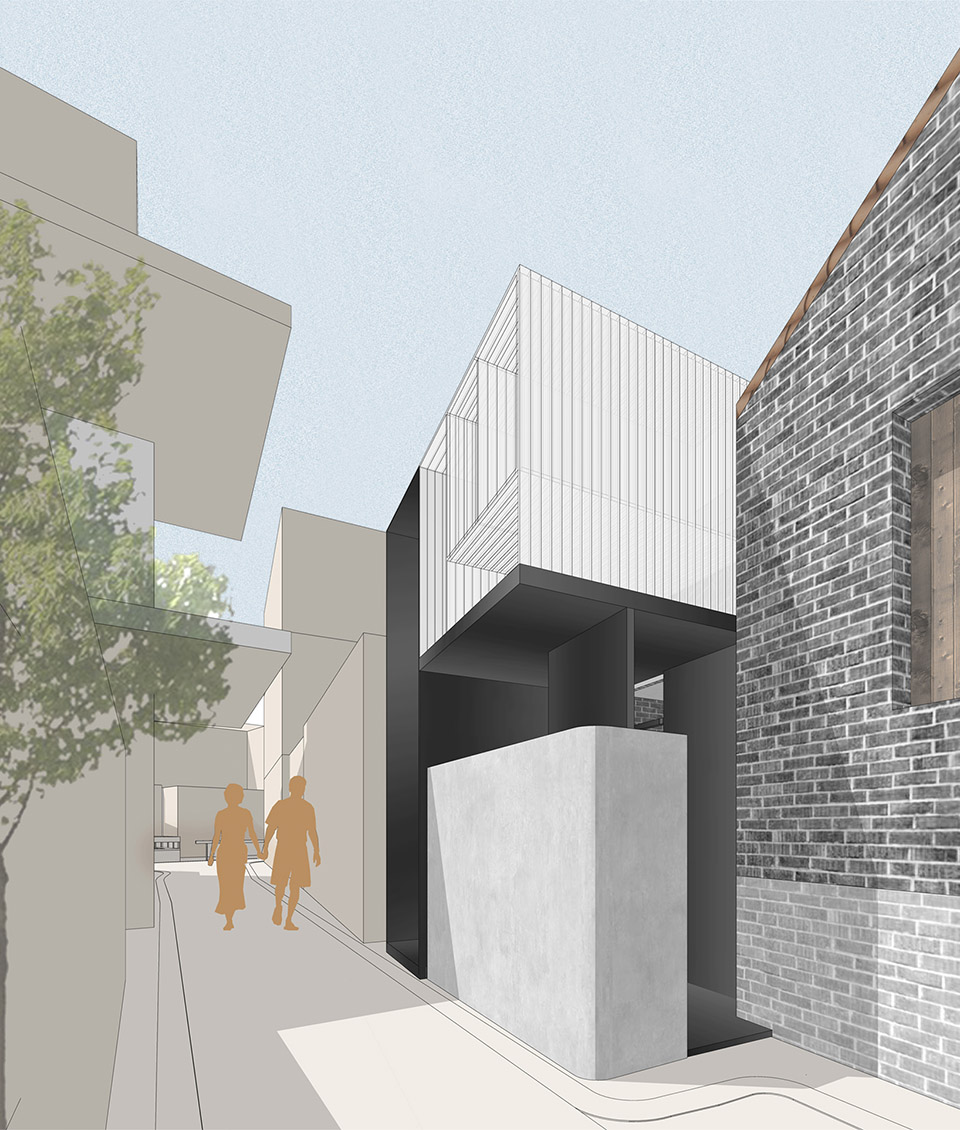
▲将立方像素系统融合进一栋老屋,Integrating a cubic pixel system into an old house ©趣城工作室

▲影像馆鸟瞰,Aerial view of the gallery ©雪里红文化 XUELIHONG
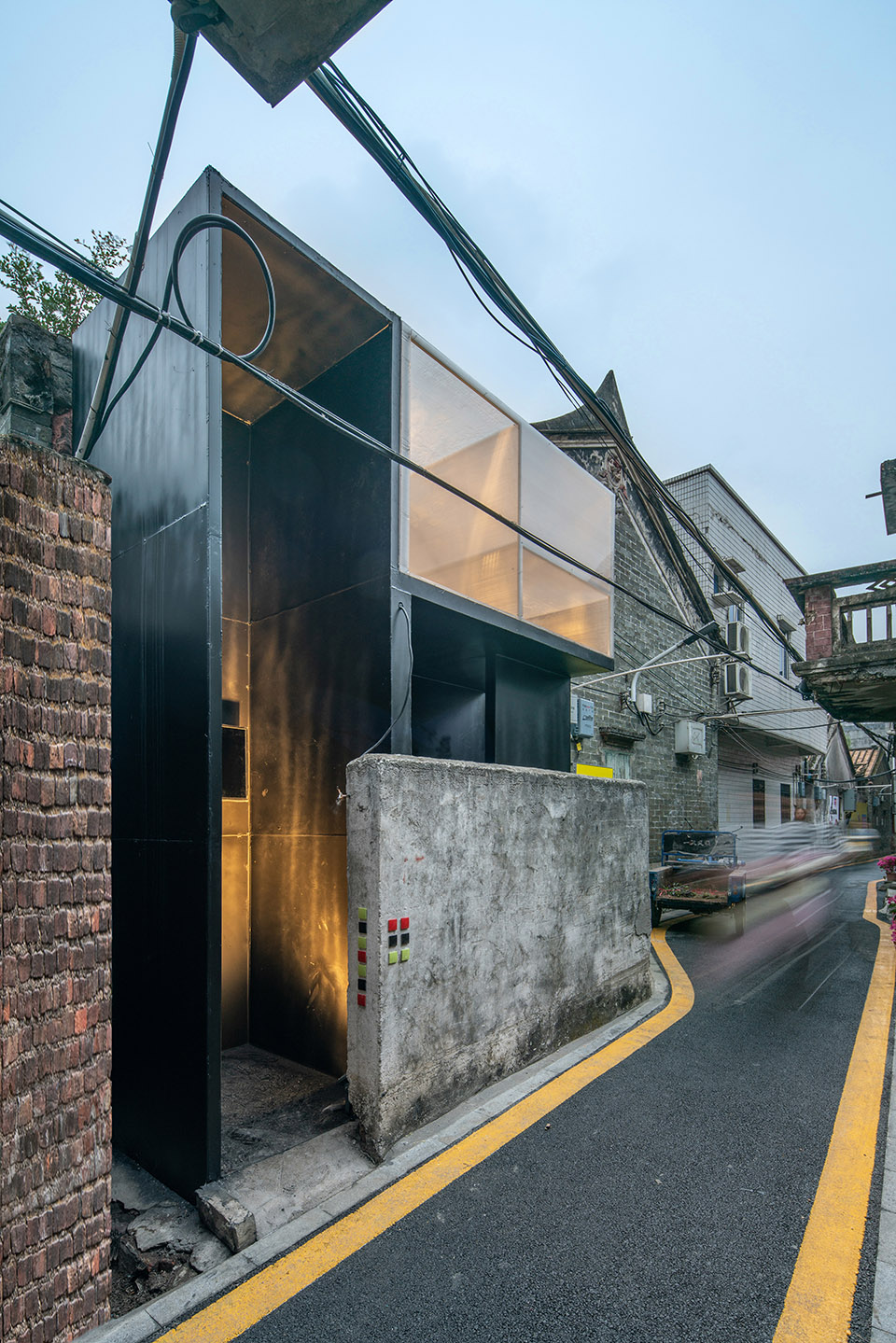
▲立方像素空间是一个开放的“媒体盒子”,Cube Pixel Space as an open “media box” ©白羽 BAI Yu

▲走在小巷中就可以看见媒体盒子里的影像作品 Walking down the alley, visitors can see the video work in the media box ©白羽 BAI Yu
时光漂流-沙井古墟新生城市现场展
Time Drift – Rejuvenation of Shajing Ancient Fair urban site-specific exhibition
沙井古墟,可能是深圳最美的地点之一,因为时间在这儿凝固了,所有与时间相关的痕迹全都在此汇聚,构成了一座“时光美术馆”。这座“时光美术馆”中,展出的是:石塔、古井、废墟、祖屋、祠堂、残垣、窄巷、飞檐、牌坊、角亭、遗迹、断碑、村屋、河流、青苔、大树、昆虫、喧声、闹市、社戏、鸡鸣、犬吠、车笛……
Shangjing Fair – where we can perceive frozen time- perhaps is the most charming place in Shenzhen. We can see time flow and then leave traces that transform Shangjing Fair to a time museum. This time museum exhibits not only stone towers, ancient wells, building ruins, ancestral houses and halls, remnants of walls, traditional alleys, eaves, memorial gates, hexagonal pavilions, relics, broken steles, cottages, but also streams, moss, trees, insects. Meanwhile we can enjoy different voices here, including people’s talking, busy fair, traditional opera, chicken crow ,dog bark and car whistle.

▲展场鸟瞰,Aerial view of the exhibition site ©雪里红文化 XUELIHONG
时光,也许是这个时代最珍贵、最奢侈、最迷人、最魅惑的消费品,因为时光既是整个世界的共同剪影,也是每一个人身体所能感知的最小体验单元。时光漂流(Time Drift)是每一个瞬间正在发生的群体事件,也是每一个地点无法阻止的共同衰变。但是“新生”却是生命中最具有戏剧性的内在能量,所有人将被重新唤醒,进入到无法预知的未来场景,所有的城市和乡村景象也都会反复重演。
Time may be the most precious, luxurious and charming consumer products in the modern society. Because time is not only the mutual silhouette of the whole world, but also the minimum unit of embodied cognition. Time Drift is a group event which condenses numerous moments and carries the meaning of a kind of unavoidable decay in all places. But rejuvenation is the most dramatic intrinsic energy in life which can wake everyone up and take them to unpredictable future scenarios. In this way, all kinds of urban and rural scenarios will repeat.

▲壁画(刘庆元),Mural (LIU Qingyuan) ©朱锐 ZHU Rui
沙井古墟正在发生的事件,与历史相连,更与未来相关。一场突如其来的展览即将进入到无比平淡的日常之溪,如同一场暴雨激起了河流泛滥。信息,正在成为真正的河流,某种意义上,我们每个人今天都生活在信息河流之中,于是与信息相关的“城市现场展”就不仅仅是一个展览,而是一种城市场景创新实验。
On one hand, the ongoing events at Shajing Fair are connected to the past but more relevant to the future. A sudden exhibition will start at the extremely prosaic stream which represents daily life – like a heavy rain that caused a flood. On the other hand, information is becoming the real stream where every individual lives. So the ‘on-site urban exhibition’ which contains abundant different information is not only a usual exhibition, but also an innovative experiment of urban scenarios.
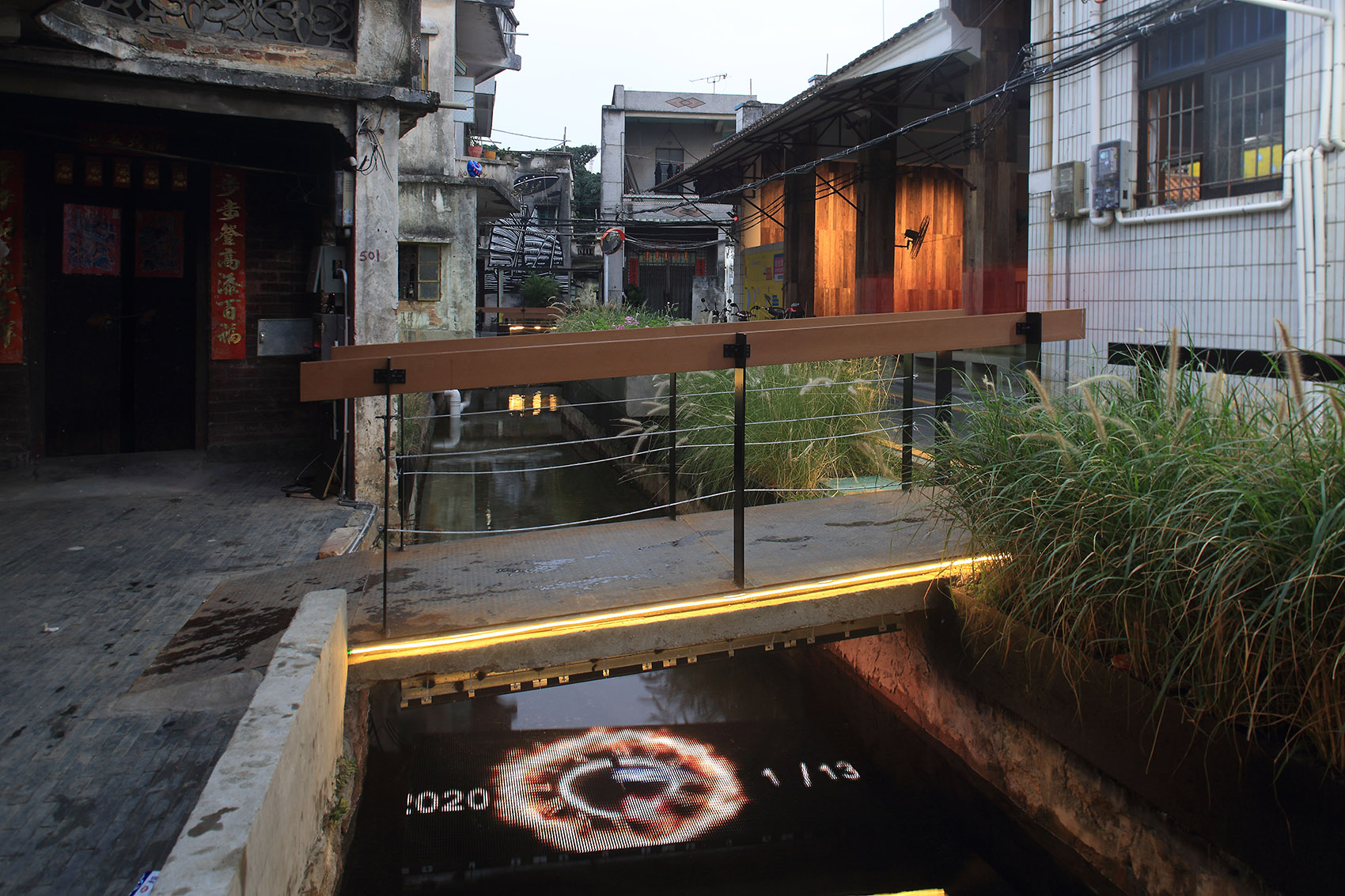
▲装置(袁俊峰/大地创想),Installation (YUAN Junfeng / Reasonable Fantasy Densign Inc) ©YUAN Junfeng
沙井的时空异质性正在被重新塑造,或许会成为全球信息网络中的奇异吸引点。这有赖于一种称之为“城市策展”的全新策略,它把信息与场景、空间与内容、经济与社会、虚拟与现实、历史与未来、自然与人文完全融合在一起,创造出独特的时空融合价值。
The spatial-temporal heterogeneity of Shajing is being reshaped and may make Shajing a singularity in the global information network. This process relies on a brand new strategy called “urban curation”, which completely integrates information and scenes, space and contents, economy and society, virtual and reality, history and future, nature and humanities to create the unique value of spatial-temporal fusion.

▲装置(张烁),Installation (ZHANG Shuo) ©快乐享印 PrintHappy

▲装置(沈少民),Installation (SHEN Shaomin) ©快乐享印 PrintHappy
用“城市策展”来重新定义“城市更新”,也许是本次展览的价值所在。我们选择了沙井,仅仅是因为,沙井也选择了我们。流逝的时光在这里重重叠印,龙津河故道犹存。时光漂流犹如一次探索之旅,将由“时间本人”来引导观者缓缓走入时空隧道,展现在面前的会是什么样的奇异景观?来吧,来看沙井古墟!时光的美和魅,取决于我们如何观看她!
We try to use ‘urban curation’ to redefine ‘urban renewal’ in this exhibition. At this moment, we choose Shajing simply because she also chooses us. The elapsed time leaves muti-layer traces here while the old path of Longjin River still exists. Time Drift is like a journey of exploration. On this journey, time will guide us to experience the spatial-temporal tunnel. What kind of miraculous scenery we will encounter here? Come to Shajing and explore the beauty and of time!

▲装置(李娜),Installation (LI Na) ©白羽 BAI Yu
策展人:张宇星、韩晶
参展人(按姓氏拼音排序):冰逸、韩晶/邱嘉玥、黄伟凯、黄引、胡向前、林奥劼、李燎、李娜、刘庆元、林芮襄、吕晓正、沈少民、刘通、孙文浩、文皆俊杰、徐子薇、袁俊峰/大地创想、姚明峰、张利华、张烁、张增增
Curators: Zhang Yuxing, Han Jing
Exhibitors:Bingyi, Han Jing/Qiu Jiayue, Huang Weikai, Huang Yin, Hu Qianqian, Lin Aojie, Li Yao, Li Na, Liu Qingyuan, Lin Rixiang, Lv Xiaozheng, Shen Shaomin, Liu Tong, Sun Wenhao, Wen Jiejunjie, Xu Ziwei, Yuan Junfeng/Reasonable Fantasy Densign Inc, Yao Mingfeng, Zhang Lihua, Zhang Shuo, Zhang Zengzeng.
三大主题单元——老屋的光与影、拓印时间、正在凝固的痕迹
Three thematic units – Light and Shadow of Old Houses, Elapsed Time, Frozen Traces
展览以光影、时间、痕迹为三条主线,伴随古老的龙津河徐徐展开。展区共划分三大主题单元——老屋的光与影、拓印时间、正在凝固的痕迹,将蚝、盐、海这些本地元素,与装置、影像、壁画、涂鸦、论坛、市集等艺术作品和公共活动融合起来,创造一种独特的城市现场展体验场景。
The exhibition unfolds slowly along the old Longjin River with three main lines: light and shadow, time and trace. The exhibition area is divided into three thematic units – Light and Shadow of Old Houses, elapsed, and Frozen Traces. Local elements such as oysters, salt and sea are combined with artworks and public activities such as installations, videos, murals, graffiti, forums and markets to create a unique urban live exhibition experience.
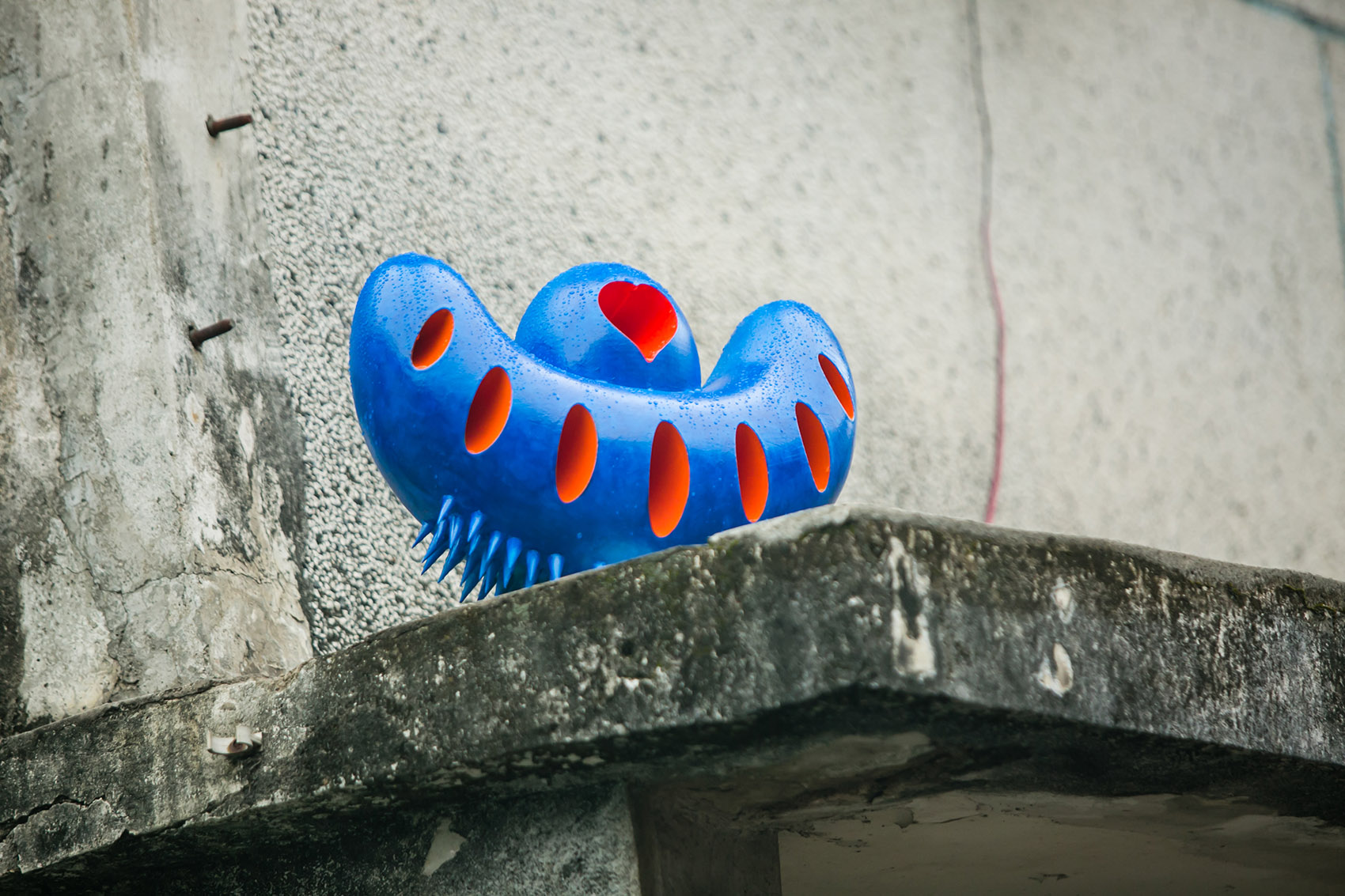
▲装置(孙文浩),Installation (SUN Wenhao) ©快乐享印 PrintHappy

▲装置(文皆俊杰),Installation (WEN Jiejunjie) ©快乐享印 PrintHappy

▲装置(林芮襄),Installation (LIN Ruixiang) ©快乐享印 PrintHappy
公共活动
Public activities
利用微改造完成的空间场地,粤剧表演、螳螂拳课堂、学术沙龙、乐队现场、古墟市集,互动工作坊、真人图书会,以及各种类型的村民自发活动在此陆续开展,激活了潜藏已久的本土文化基因。多种形态的文化活动因为空间和展览的媒介作用,在千年古墟中相互碰撞出火花,并进一步链接了个体之间的合作与互动。设计与艺术,让这种链接充满情感与温度,一个又一个纯粹而又创新的“本地性”被发现、创造出来。
Using the redesigned space, Cantonese opera performances, mantis boxing classes, academic salons, live bands, ancient marketplaces, interactive workshops, live book clubs, and various types of villagers’ spontaneous activities were held one after another, activating the long-hidden local cultural genes. The multiple cultural activities enhance the cooperation and interaction between individuals supported by public spaces and exhibitions. Design and art fill this link with emotion and warmth, and pure and innovative “locality” is discovered and created here.

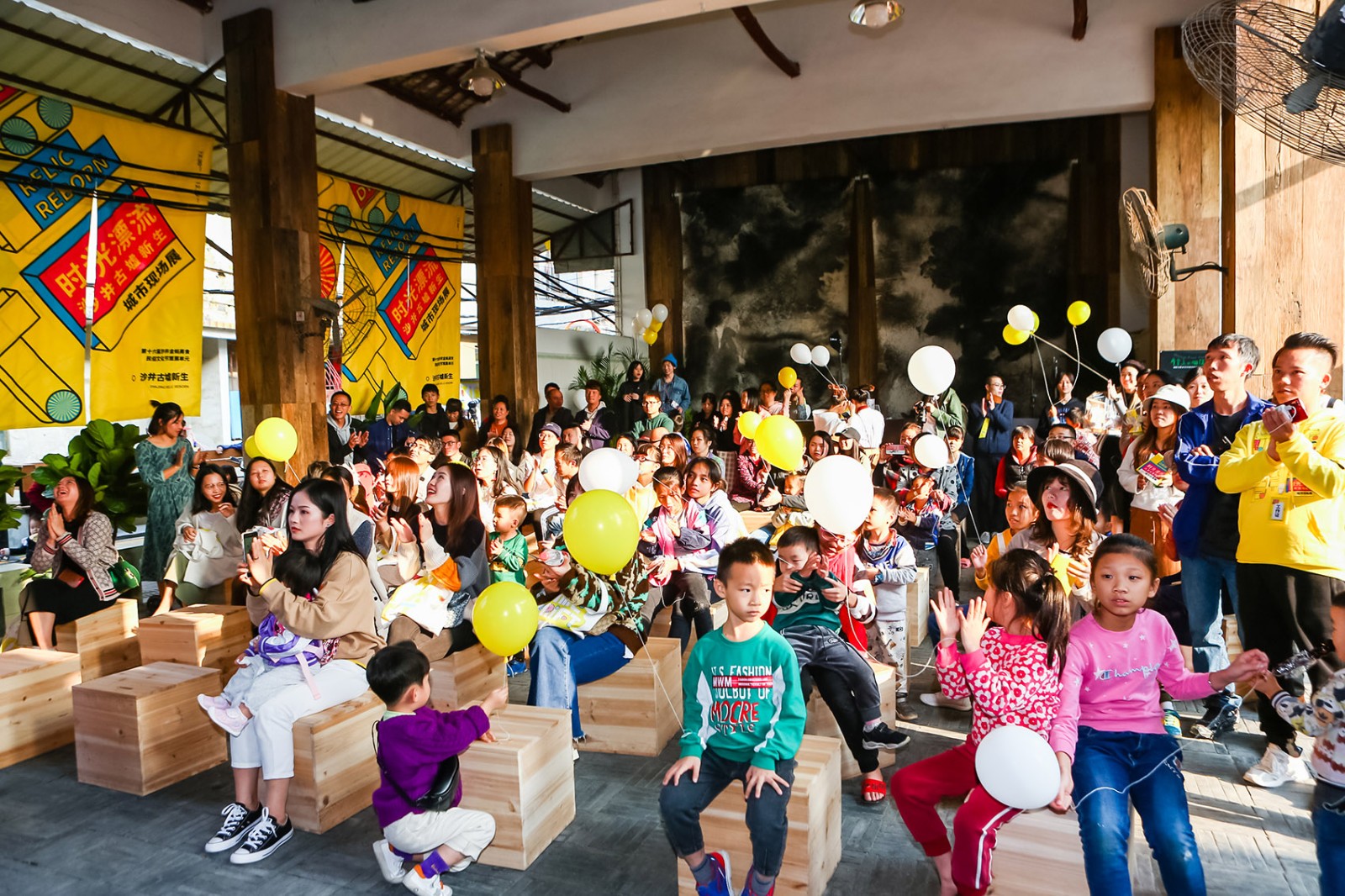
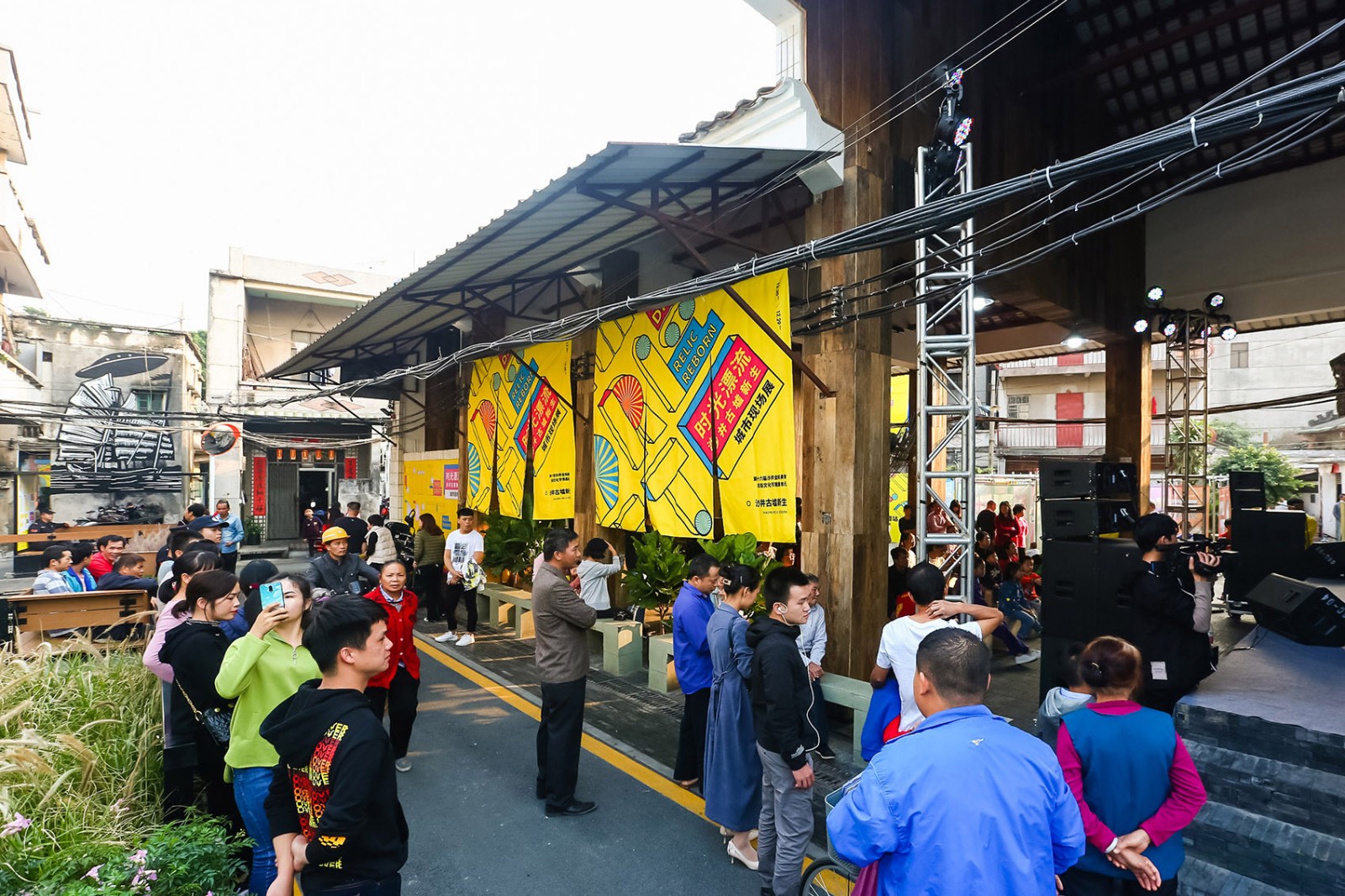
▲戏台重新成为有活力的在地公共空间,Public Stage as a vibrant local public space ©快乐享印 PrintHappy
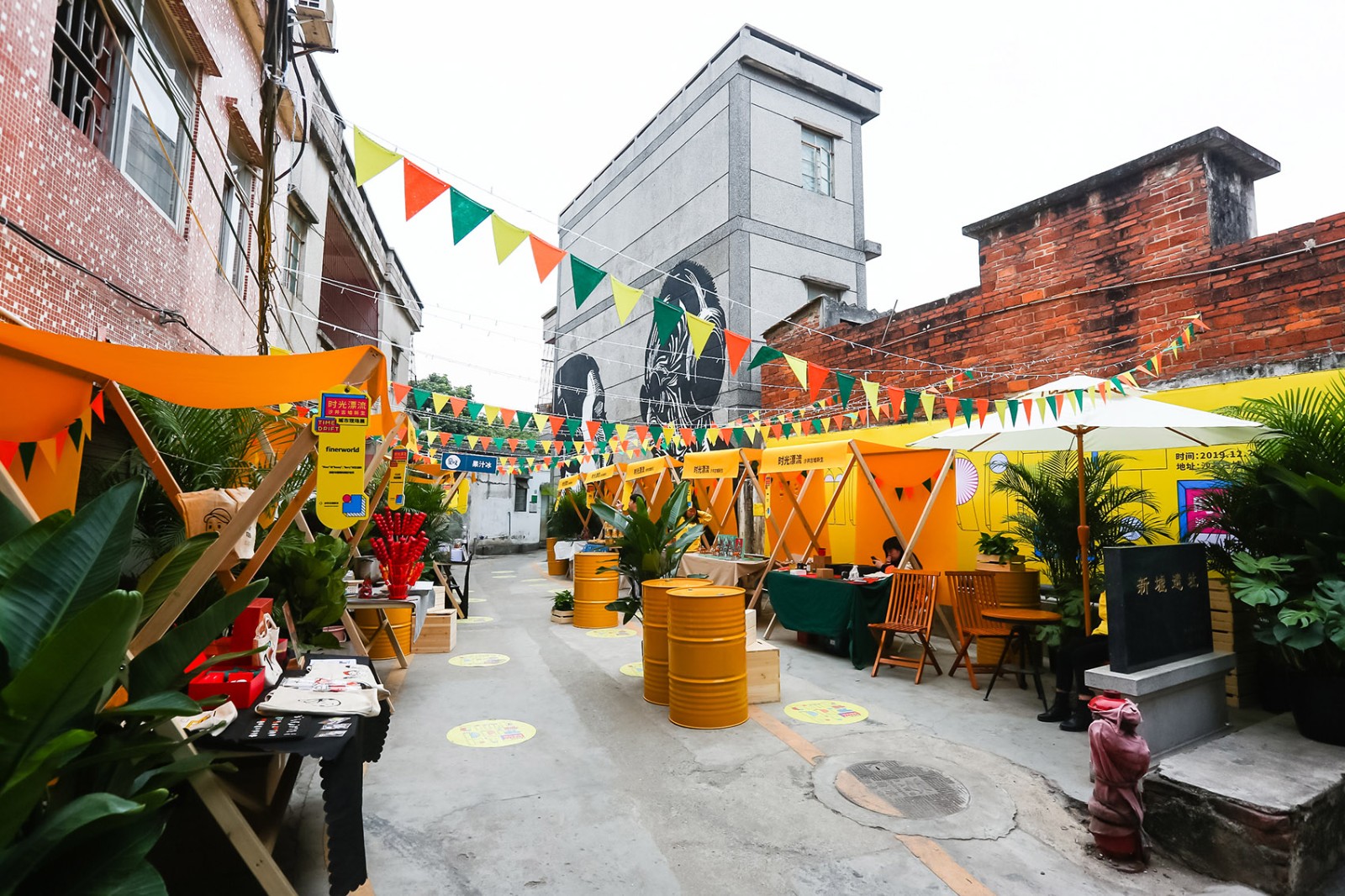

▲在古墟遗址恢复市集,Bazaars at ancient ruin sites ©快乐享印 PrintHappy


▲儿童是本地文化传统的传承人,Children as bearers of local cultural traditions ©快乐享印 PrintHappy
时光漂流-沙井古墟新生城市现场展,既是设计也是展览,既是保护也是激活,既是景观也是观景,既是更新也是怀旧,既是日常也是戏剧……它融合了多种要素,试图将过去和未来、历史与当代、在地或遥远完整铸造在一起,形成具有充满时空张力的场景状态。作为一个新的空间价值模型实验,也许才刚刚开始,我们也期待沙井古墟因为这次实验行动,而开启一次缓慢却又深刻的时空演化历程。
Time Drift – Rejuvenation of Shajing Ancient Fair site-specific exhibition is both a design and an exhibition, a kind of preservation and activation, a landscape and a view, a renewal and a nostalgia, a daily life and a drama …… It combines various elements, attempting to bring together past and future, history and contemporary, local and distant, to form a city full of theories and ideas of the past and the present. The state of the scene in spatiotemporal tension. As a new spatial value model experiment, which may have just begun, we also expect the manhole ancient ruins to start a slow but profound spatio-temporal evolutionary journey because of this experimental action.

▲方案总平面 Site Plan ©趣城工作室

▲废墟花园 Ruin Garden(EAST ELEVATION, SOUTH ELEVATION) ©趣城工作室

▲老屋平面、立面 Old House(1ST FLOOR PLAN, NORTH ELEVATION) ©趣城工作室

▲戏台平面、立面 Public Stage (1ST FLOOR PLAN, NOTRH ELEVATION) ©趣城工作室
项目名称:沙井古墟新生
建筑师:趣城工作室(ARCity Office)/趣城(上海)规划建筑设计有限公司
地址:沙井大街,宝安区,深圳,广东,中国
项目年份:2019
建筑面积:1000.0 平方米
场地面积:3000.0平方米
主持建筑师:张宇星、韩晶
项目建筑师:邱嘉玥、张嘉乐
景观协作单位:深圳大地创想建筑景观规划设计有限公司
业主:深圳市宝安区沙井街道办、华润置地集团
展览视觉设计:SURE Design
摄影师:白羽、朱锐、快乐享印
航拍摄影:雪里红文化
Project Name: Rejuvenation of Shajing Ancient Fair
Architect: ARCity Office
Address: Shajing Street, Bao’an District, Shenzhen, Guangdong, China
Project year: 2019
Building area: 1000.0 m2
Area: 3000.0 m2
Host architects: ZHANG Yuxing, HAN Jing
Project Architect: QIU Jiayue, ZHANG Jiale
Landscape Collaboration Unit: Reasonable Fantasy Densign Inc
Owner: Shenzhen Bao’an District Shajing Street Office, China Resources Land Group
Exhibition visual design: SURE Design
Photographers: BAI Yu, ZHU Rui, PrintHappy
Aerial Photography: XUELIHONG
版权声明:本文版权归原作者所有,如有侵犯您的权益请及时联系,我们将第一时间删除。
投稿邮箱:info@landscape.cn
项目咨询:18510568018(微信同号)
